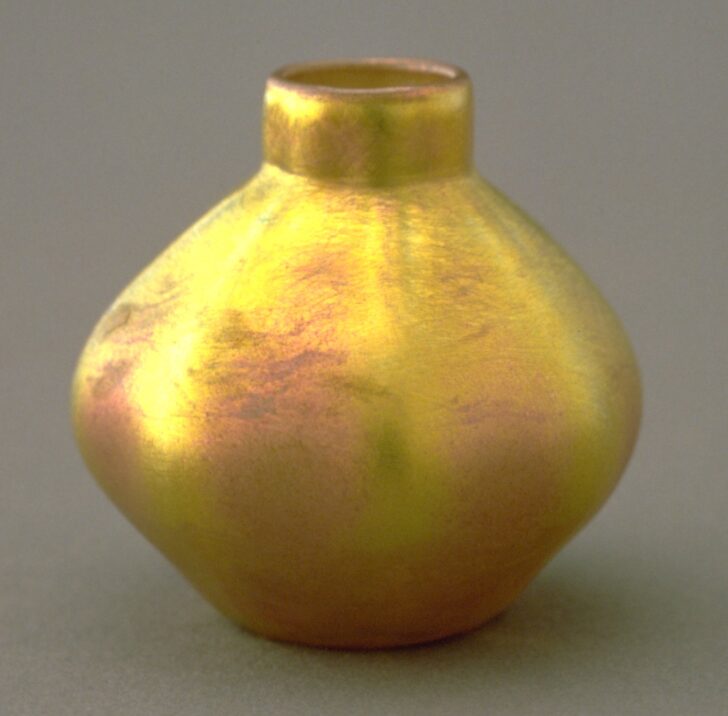Miniature vase
Louis Comfort Tiffany

Description
Henry and Lousine Havemeyer were active collectors of the favrille, or hand-made, iridescent glass made by Louis Comfort Tiffany. Tiffany had been known for making leaded windows since the late 1870s, but only began to make blown-glass vessels in the early 1890s—not long after his work on the Havemeyer house in New York. Working with Tiffany to select outstanding pieces, the Havemeyers amassed an impressive collection of Tiffany’s favrille glass; most of it was donated by the family to the Metropolitan Museum of Art. Most of the Tiffany glass in the University of Michigan’s collection was purchased at auction (along with the architectural fragments) by Emil Lorch in 1930.
(C. McNamara, 18th-19th Century Gallery installation, early 1999)
In conversation with Jennifer Perry Thalheimer, Collections Manager, Charles Hosmer Morse Museum, Rollins College, Winter Park, FL (6/27/06) comes the following information:
The label on the bottom of the vessel FAVRILE T G D CO stands for Tiffany Glass and Decorating Company and was added to glass works created between 1892 and 1900 (although a few were used after 1900).
Those works initialed with L.C.T. or in which Tiffany's name is written out on the base does not indicated that Tiffany himself was responsible for the creation of the work. Although he passed design ideas to his artists, he did not personally oversee the creation of all of his works. As other favrile glass artists began to compete with Tiffany, the initials may have been just to establish that the work came from the Tiffany company studio.
There is work ongoing about the numbers on paper labels or etched into the bases of Tiffany glass works to establish what they might indicate as to dating, style, inventory, etc.
Subject Matter:
Tiffany was conversant with glass (both mosaics and blown glass vessels) from different cultures and epochs, including that of ancient Rome. This miniature vase exhibits Tiffany's mastery of asymmetrical form (which recalls late antique glass as well as sharing in the aesthetic of Art Nouveau) and recalls the beautiful small bottles that contained perfumes or precious oils excavated from Roman sites. Tiffany's gorgeous use of color and iridescence in a small vase such as this also evokes the iridescence of excavated Roman glass--not an intended effect in the Roman work but a result of chemical changes in the glass as a consequence of contact with acidic and moist earth. In this small vase, Tiffany conjures up all the rich association of late Roman glass as well as the opulent color and lines of Tiffany's contemporary arts and crafts.
Physical Description:
Miniature vase of irregular, slightly globular form; vessel has suggestions of lobes and has a narrow neck. Exterior of vase exhibits a deep yellow and pinkish iridescent surface with an overall effect of rich color and natural aysmmetry.
Usage Rights:
If you are interested in using an image for a publication, please visit https://umma.umich.edu/request-image/ for more information and to fill out the online Image Rights and Reproductions Request Form.